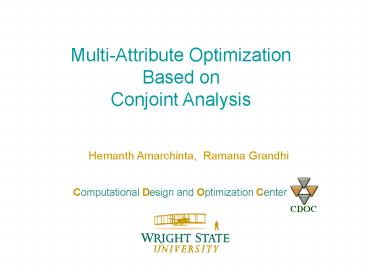Basics of MOO PowerPoint PPT Presentation
1 / 22
Title: Basics of MOO
1
Multi-Attribute OptimizationBased on Conjoint
Analysis
Hemanth Amarchinta, Ramana Grandhi
Computational Design and Optimization Center
2
Outline
- Conjoint Analysis
- Combining Marketing and Engineering
- Engineering Applications
- Conclusions
- Understanding Multi-Attribute Optimization
- Methods available
? Constrained Method ? Weighted Sum Method
? Camera Example
? Cantilever Beam Example
3
Solving MAO
STEP1
S T E P 2
Higher level Information is needed
Multiple tradeoffs obtained
Choosing one solution
4
Methods
- Constraint Method
- Weighted Sum Method
- Value function Method
- Evolutionary Methods
Constraint Method Weighted Sum Method
5
Constrained Method
Subject to
- Preference is set by maximum levels, No real
trade-offs - If ,
6
Weighted sum method
Here Constraints are converted into an objective
function by assigning weights to each function
- Pay 10 for each increase in comfort level,
regardless - of current comfort level which may not be
true
7
Conjoint Analysis (CA)
Conjoint analysis is a technique to break down
attributes for deriving Part Worth associated
with attributes for each level of a product based
on the overall preferences of choice alternatives
by a group of respondents.
Buying a Car Make Two door or Four
Door Engine Color
How much importance is given to each attribute ?
8
CA Camera Example
Quality Price
Attributes
Levels for Each attribute
Quality ? High, Medium, Low Price ? 200, 400,
600
Combinations
3 x 3 9 Combinations
Questionnaire Rank based
Preferences
9
CA Camera Example
Dummy variable method and Least Squares are used
to calculate Part Worth
- We know which attribute is important
- We know range of importance
- Part Worth provides valuable information in
developing a new product
10
Combining Marketing and Engineering
Marketing
11
Cantilever Beam
12
Displacement Study
Aim Minimize mass and tip displacement
13
Displacement Study Contd
Conjoint-based Approach
14
Displacement Study Contd
Result Obtained Mass 1.7963 lb Max Disp 0.1104
in Width 0.5in, Height 1.7963in
For a 11 increase in Mass, there is a 26
decrease in Displacement
15
Disp Stress Study
Aim Minimize mass, displacement and stress
16
Disp Stress Study contd..
4 levels for each attribute are considered Total
of 64 combinations are possible, Only 30
combinations are considered and ranking based
preference is followed
Calculated Part Worths
17
Disp Stress Study contd..
f1
f2
f3
Min f1f2f3
Results obtained Mass 2.3094 lb Stress
9000.08 psi Displacement 0.052 in Width 0.5 in
, Height 2.3094 in
18
Conclusions
- Preference - based optimization is needed
- Conjoint Analysis provides a trade-off solution
- Techniques from other fields can be used as
shown - Applications to Engineering are shown by solving
cantilever - beam example
19
Thank for your time
20
- Cutting the slides as time is not enough for
presentation
21
Understanding MAO
Aim Minimize Cost and Maximize Comfort
- We have multiple optimum solutions
- For Comfort as criterion Solution 2 is best
- For Cost as criterion Solution 1 is best
- Sacrifices--a, b, c, d are candidate
- solutions
- No solution is superior
22
Flow Chart for CA

